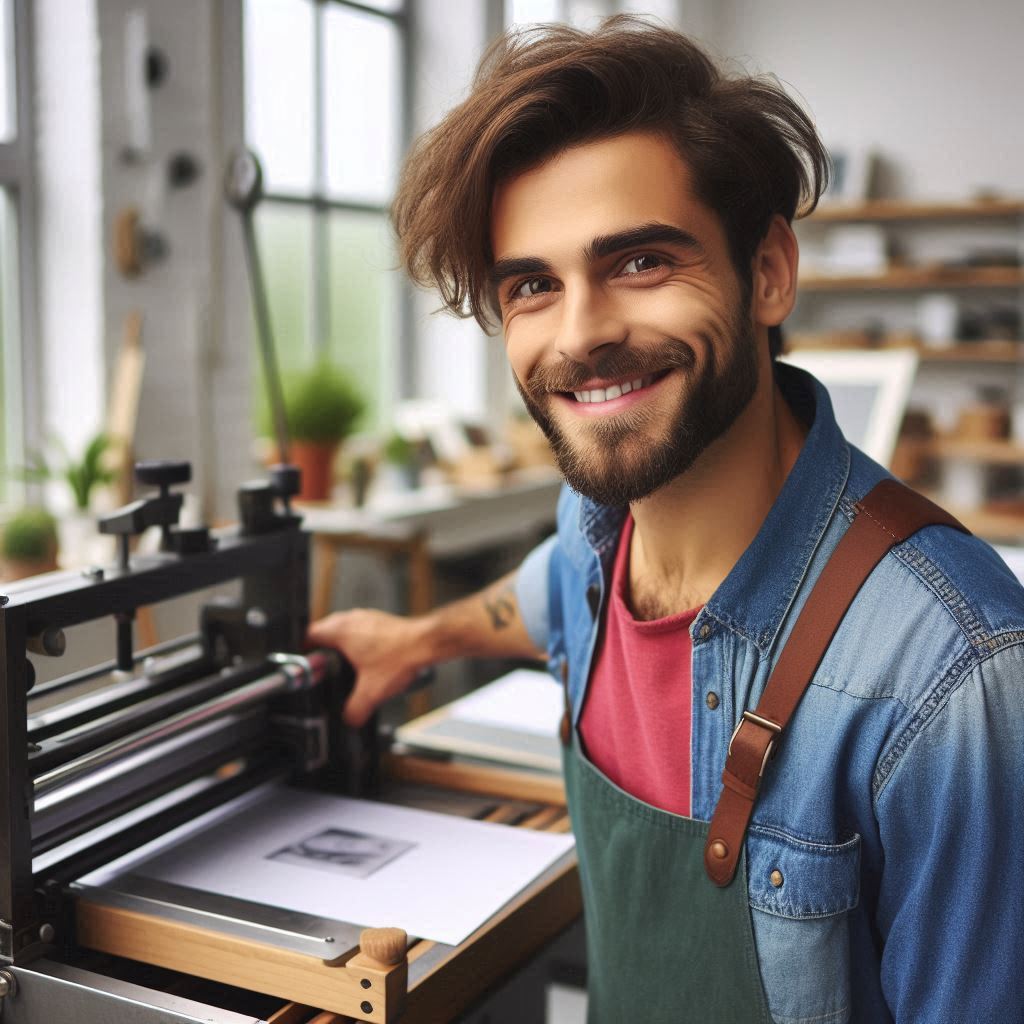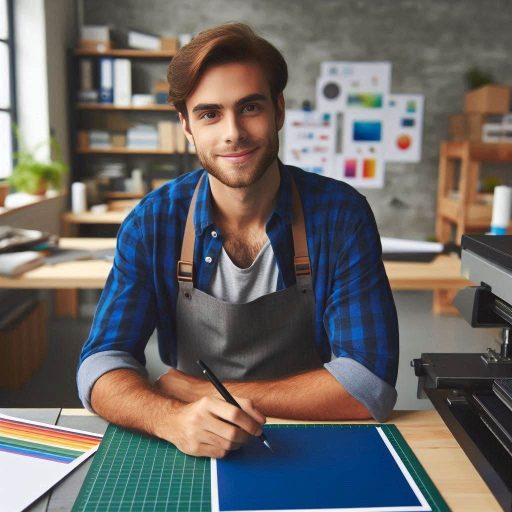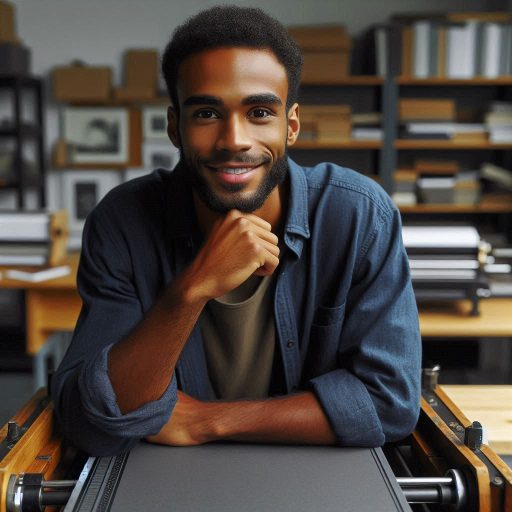Introduction
Printmaking involves creating artworks by transferring images onto surfaces through various techniques like etching or linocut.
As an art form, printmaking offers a unique way for artists to express their creativity and showcase their skills.
To excel in printmaking, artists must possess specific skills that enable them to master the craft and create stunning pieces.
Technical Skills
An artist must have a strong understanding of different printmaking techniques such as intaglio, relief, lithography, and screen printing.
Proficiency in handling tools like carving tools for linocut, etching needles for intaglio, and brushes for lithography is essential.
Knowledge of how to properly prepare materials such as plates, inks, and paper is crucial for achieving successful prints.
Creative Skills
Having a keen eye for composition, color theory, and design principles is important in creating visually appealing prints.
Experimentation and willingness to take risks are key traits that enable artists to push boundaries and explore new techniques.
Problem-solving skills come in handy when issues arise during the printmaking process, requiring quick thinking and adaptability.
Attention to Detail
Being meticulous in executing each step of the printmaking process is necessary to ensure the quality and precision of the final print.
Patience is a virtue in printmaking, as some techniques require multiple layers or passes to achieve the desired result.
Attention to detail also extends to maintaining a clean workspace and properly caring for tools and equipment to prolong their lifespan.
By honing their technical and creative skills, along with cultivating an eye for detail, artists can excel in the intricate art of printmaking.
Creativity
Ability to think outside the box
Creativity drives the heart of printmaking. It starts with the ability to think outside the box.
This means breaking away from traditional methods and exploring new possibilities.
Innovative ideas can lead to groundbreaking prints that captivate viewers.
Experimenting with different techniques
Experimenting with different techniques is a crucial part of this process.
By trying out various printmaking methods—such as etching, lithography, or screen printing—artists discover new textures and effects.
Each technique offers unique opportunities for creative expression.
Embracing these methods can lead to unexpected and exciting results.
Transform Your Career Today
Unlock a personalized career strategy that drives real results. Get tailored advice and a roadmap designed just for you.
Start NowDeveloping a unique style in printmaking
Developing a unique style in printmaking also requires creativity.
A distinct style sets an artist apart and makes their work recognizable.
This involves a combination of personal preferences, experiences, and technical skills.
Over time, artists refine their style by continuously experimenting and reflecting on their work.
Creativity fuels innovation in printmaking.
It allows artists to push boundaries and explore new horizons.
By thinking outside the box, experimenting with techniques, and cultivating a unique style, printmakers enhance their craft and make significant contributions to the art world.
Read: Tips for Maintaining Your Ceramic Art Studio
Attention to detail
Attention to detail is crucial in printmaking for achieving accurate and refined results. Here are some key points to consider:
Precision in Carving or Etching Designs
When creating linocuts or etchings, it is essential to be meticulous in carving or etching the designs.
Pay close attention to every line and curve to ensure the final print reflects your intended design accurately.
Focus on Intricate Patterns and Textures
In printmaking, intricate patterns and textures can add depth and visual interest to your prints.
Take the time to carefully craft these details, whether through carving, etching, or other printmaking techniques.
Ensuring Clean and Precise Printing Results
Once the design is complete, the printing process requires precision to achieve clean and crisp results.
Pay attention to the amount of ink, pressure applied, and paper quality to ensure each print is of high quality.
By focusing on attention to detail in every step of the printmaking process, you can elevate your prints and create stunning works of art that showcase your dedication and skill.
Patience
Time-consuming process of printmaking
Printmaking is a meticulous art form that demands patience at every stage.
The process can be time-consuming, requiring a careful approach.
Artists must invest hours, sometimes days, to achieve the desired results.
Multiple steps are involved in creating a print
Each printmaking process involves multiple steps.
Transform Your Career Today
Unlock a personalized career strategy that drives real results. Get tailored advice and a roadmap designed just for you.
Start NowFirst, the artist creates a design, which they then transfer onto a plate or block.
After that, the plate is inked, and paper is carefully placed.
Each step must be executed with precision and care.
The artist needs to check and adjust their technique as they proceed.
Willingness to take the time to perfect each print
Patience is crucial throughout these steps. Artists must wait for inks and materials to dry.
They may need to make adjustments to achieve the perfect balance of ink and pressure.
This waiting time can be frustrating, but it is necessary for a successful print.
The process of developing skills in printmaking is gradual.
Each print teaches the artist more about their materials and techniques.
A willingness to spend time refining each print is essential.
This dedication to perfecting each piece leads to improved skills and more rewarding results.
In review, patience is not just a virtue but a necessity in printmaking.
The time-consuming nature of the process and the multiple steps involved make it clear that patience is key.
Artists who are willing to invest time in perfecting each print will ultimately find greater satisfaction and success in their craft.
Read: How to Frame and Preserve Printmaking Art
Knowledge of materials
Understanding different types of printmaking tools
When it comes to excelling in printmaking, having a deep understanding of the materials involved is crucial.
Printmaking tools come in various forms such as brayers, carving tools, and printing presses.
Each tool serves a specific purpose, and knowing how to use them properly can significantly impact the quality of the final print.
Familiarity with various printing papers
Additionally, being familiar with different types of printing papers is essential.
Different papers have unique textures, weights, and absorbencies that can affect how the ink appears on the paper.
Transform Your Career Today
Unlock a personalized career strategy that drives real results. Get tailored advice and a roadmap designed just for you.
Start NowUnderstanding these characteristics can help artists choose the right paper for their specific printmaking project.
Knowing how to mix and apply inks effectively
Ink is another essential material in printmaking, and knowing how to mix and apply inks effectively is a skill that can elevate the quality of the prints.
Artists should understand the properties of various inks, such as viscosity and drying time, to achieve the desired results in their prints.
By gaining knowledge of these materials and how to work with them effectively, printmakers can enhance their skills and produce high-quality prints that stand out.
Practice and experimentation with different materials are key to mastering the art of printmaking.
Read: Ceramic Art as a Therapeutic Practice

Technical skills
Mastering the technical skills required for printmaking is essential for excelling in this art form.
Printmakers must have a deep understanding of the tools and equipment involved in the process to create high-quality prints.
Proficiency in using printing presses
Printmakers need to be well-versed in the operation of various types of printing presses.
They should know how to set up and adjust the press to achieve the desired results in their prints.
Ability to operate carving and etching tools
Printmaking often involves carving or etching designs onto plates or blocks.
Printmakers must have the skills to use these tools effectively to create intricate and precise details in their prints.
Understanding the science behind ink and paper interactions
A crucial aspect of printmaking is understanding how different types of ink and paper interact with each other.
Printmakers need to know the properties of various inks and papers to choose the best materials for their prints.
By developing technical skills such as proficiency in using printing presses, the ability to operate carving and etching tools, and an understanding of ink and paper interactions, printmakers can set themselves up for success in the world of printmaking.
Read: Printmaking Techniques: Monotype Printing
Problem-solving abilities
Troubleshooting issues with printing equipment
Developing strong problem-solving abilities is essential for excelling in printmaking.
Printmakers often encounter technical issues with their printing equipment that can disrupt their workflow and affect the quality of their prints.
It is crucial to be able to troubleshoot these issues effectively to minimize downtime and ensure that the printing process runs smoothly.
Finding creative solutions to artistic challenges
Having a creative mindset is also important when facing artistic challenges in printmaking.
Transform Your Career Today
Unlock a personalized career strategy that drives real results. Get tailored advice and a roadmap designed just for you.
Start NowPrintmakers may encounter issues such as color inconsistencies, registration errors, or unexpected results in their prints.
Being able to think outside the box and come up with innovative solutions to these challenges can help elevate the quality of their work and push the boundaries of their creativity.
Adaptability to changes in the printing process
Adaptability is another key skill that printmakers should possess.
The printing process can be complex and unpredictable, with various factors such as humidity, temperature, and ink viscosity affecting the final outcome of the print.
Printmakers must be able to adapt to these changing conditions and make adjustments to their process on the fly to achieve the desired results.
Being flexible and open to experimentation can lead to breakthroughs in printmaking techniques and artistic expression.
In general, problem-solving abilities, creative thinking, and adaptability are essential skills for printmakers looking to excel in their craft.
By honing these skills, printmakers can overcome challenges, push their creative boundaries, and produce high-quality prints that truly stand out.
Collaboration
Working with other artists on collaborative prints
Collaboration is crucial for success in printmaking.
Working with other artists can enhance creativity and technical skills.
Collaborative prints often merge different styles and techniques, resulting in unique artwork.
Artists learn to adapt and incorporate new ideas through teamwork.
Learning from experienced printmakers
Collaborating with experienced printmakers offers invaluable learning opportunities.
These seasoned professionals share their expertise, from technical skills to creative processes.
Observing their methods and receiving feedback can accelerate skill development.
Their guidance helps avoid common pitfalls and refines artistic techniques.
Networking opportunities in the printmaking community
Networking within the printmaking community opens doors to new opportunities.
Engaging with fellow artists provides insights into current trends and techniques.
It also fosters relationships that can lead to joint projects and exhibitions.
Networking events, workshops, and online forums are ideal for making connections.
Transform Your Career Today
Unlock a personalized career strategy that drives real results. Get tailored advice and a roadmap designed just for you.
Start NowAttending printmaking workshops and conferences further expands your network.
These events offer a platform to showcase your work and meet potential collaborators.
They also provide access to a broad range of perspectives and skills.
Building these relationships can lead to collaborative projects and mutual growth.
In summary, collaboration in printmaking enriches the creative process.
Working with other artists and learning from experts enhances technical and artistic skills.
Networking within the community offers opportunities for growth and collaboration.
Embrace these aspects to excel and advance in the field of printmaking.
Collaboration in printmaking can be a rewarding experience, offering opportunities for growth, learning, and connection within the artistic community.
By working with others, you can expand your skills, explore new techniques, and create unique and exciting prints that reflect the diverse perspectives and talents of a group of artists working together towards a common goal.
Conclusion
Developing Skills for Printmaking
- Attention to Detail: Maintaining precision in carving and printing is crucial for achieving high-quality prints.
- Patience and Persistence: Learning printmaking techniques takes time and practice. Don’t get discouraged by initial setbacks.
- Creativity and Innovation: Experiment with different materials and techniques to develop your unique artistic style.
- Technical Proficiency: Understand the tools and equipment used in printmaking to produce professional-looking prints.
- Adaptability and Problem-Solving Skills: Be prepared to troubleshoot and make adjustments during the printing process to ensure successful outcomes.
- Collaboration and Communication: Working with other artists or printmakers can enhance your skills and broaden your perspective.
- Continuous Learning and Improvement: Stay updated on new techniques and trends in printmaking to continue growing as an artist.
Mastering the necessary skills in printmaking is essential for producing remarkable artworks.
Aspiring printmakers should focus on developing these skills with dedication and practice.
Remember, excellence in printmaking requires continuous effort and commitment.
Practice, learn, and refine your skills to achieve success in this intricate art form.




